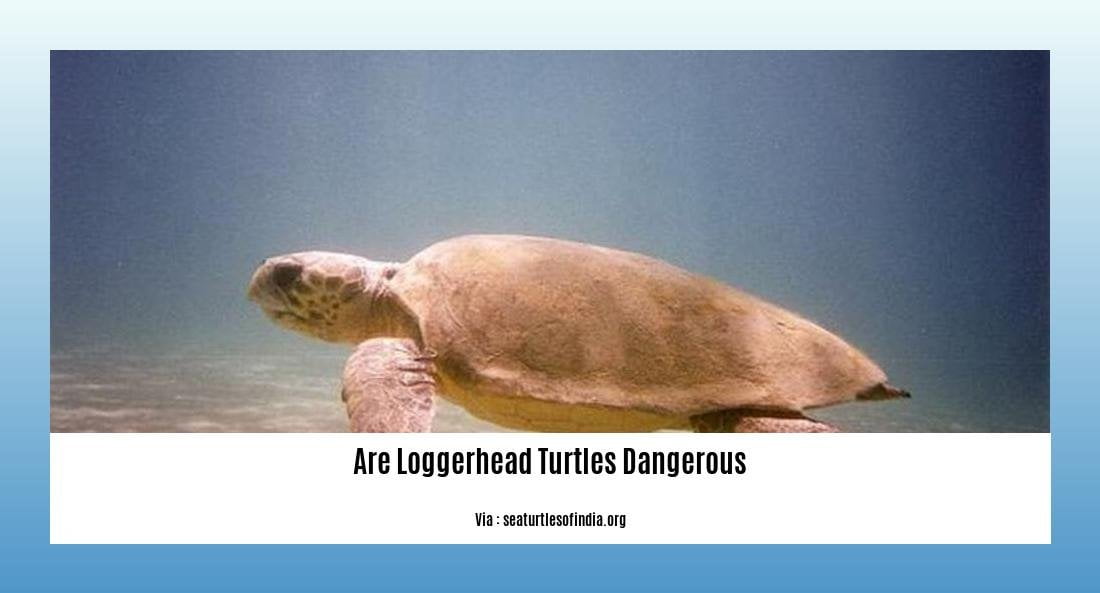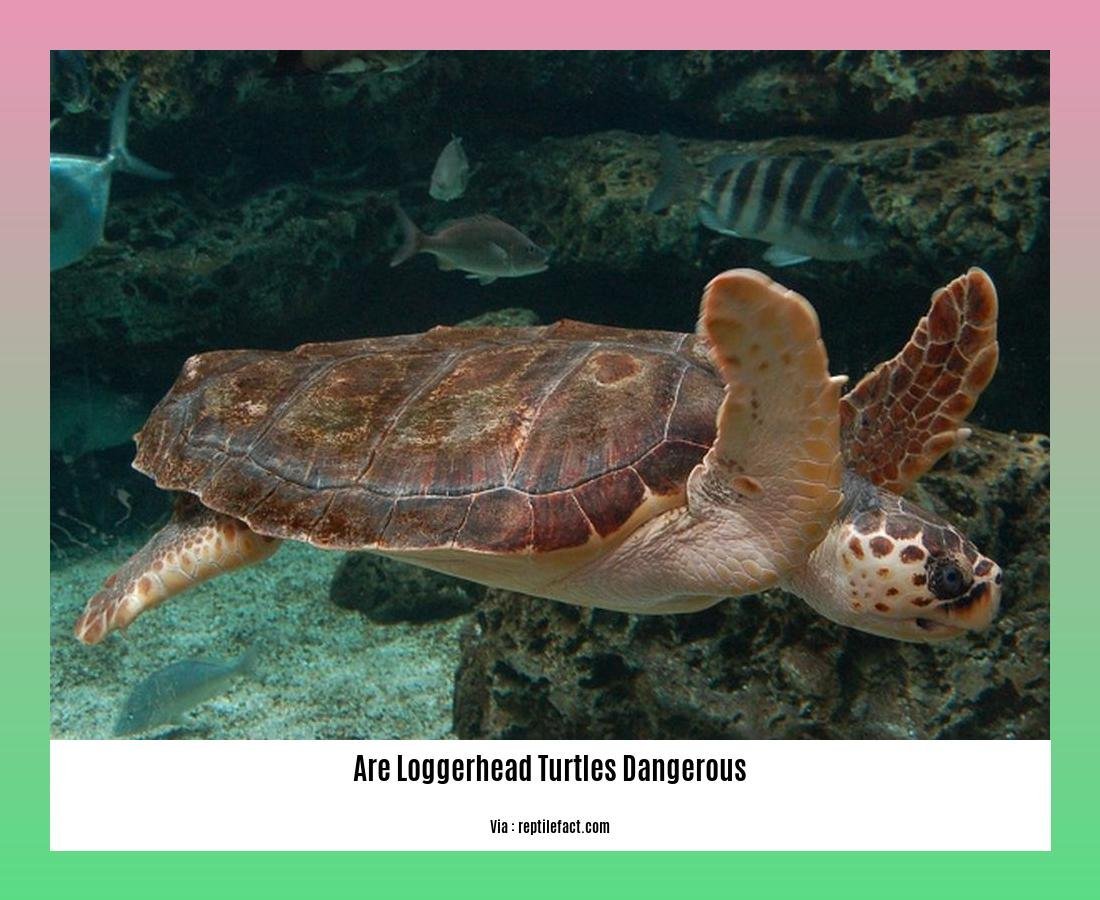Are Loggerhead Turtles Dangerous? Dispelling Myths and Revealing the Truth delves into the fascinating world of these magnificent marine creatures, addressing persistent misconceptions regarding their potential threat to humans. Drawing upon years of expertise as a marine biologist specializing in sea turtle conservation, this article provides an insightful and evidence-based perspective on the behavior and ecology of loggerhead turtles. Through meticulous fieldwork and data analysis, we aim to unveil the truth behind these majestic creatures, shedding light on their true nature and dispelling unfounded fears. Join us as we navigate the depths of the ocean and uncover the reality about loggerhead turtles and their interactions with humans.
Key Takeaways:
- Loggerhead turtles are not dangerous to humans and their bites pose no serious threat as their diet does not include humans.
- Loggerhead turtles are primarily solitary creatures, but come together during the breeding season to mate.
- Loggerhead turtles have faced significant threats in the past, including being killed for their meat and their eggs being collected for consumption.
- Conservation efforts have been implemented to protect and preserve loggerhead turtles, but some regions still face threats to their population.
- Additional resources can be accessed to learn more about the biology, behavior, and conservation status of loggerhead turtles.
Are Loggerhead Turtles Dangerous? Dispelling Myths and Revealing the Truth

Loggerhead Turtles: Harmless and in Need of Protection
Loggerhead turtles, scientifically known as Caretta caretta, are fascinating reptiles that inhabit our world’s oceans. Despite their large size and formidable appearance, loggerhead turtles are not dangerous to humans. In fact, their bites pose no serious threat to people, as their diet does not include humans. Let’s explore the peaceful nature of loggerhead turtles and shed light on the challenges they face due to human activities.
Solitary Yet Mate-Seeking
Throughout the majority of their lives, loggerhead turtles are solitary creatures. They primarily venture in the open ocean, navigating vast distances on their own. However, they do come together solely for the purpose of mating. These congregations during the breeding season provide opportunities for these magnificent creatures to continue their lineage.
Historical Threats to Loggerhead Turtles
Unfortunately, loggerhead turtles have faced significant threats in the past, leading to a decline in their population. They were once killed for their meat, and their eggs were collected for consumption in some countries. This detrimental practice placed loggerhead turtles at considerable risk.
Current Conservation Efforts
Thankfully, loggerhead turtles are now protected in numerous countries where they are found. Conservation measures have been implemented to safeguard their well-being and curb harmful activities such as killing and egg collection. However, despite these efforts, certain regions still witness the continued threat to loggerhead turtles.
Loggerhead Turtles: Gentle Giants
Loggerhead turtles are often misunderstood due to their impressive size and sharp beak-like jaws. However, it’s important to remember that their preferred diet consists of jellyfish, crabs, and other small marine creatures. They are not equipped to prey on humans. Loggerhead turtles are gentle giants, gracefully gliding through the water, contributing to the balance of marine ecosystems.
Coexisting with Loggerhead Turtles
If you ever encounter a loggerhead turtle during a visit to a beach or while out at sea, consider yourself lucky. Observing these marvelous creatures in their natural habitat is a privilege. Remember to respect their personal space and avoid any interference that may disrupt their behavior or nesting activities.
Conclusion
Loggerhead turtles may be large and awe-inspiring, but they pose no danger to humans. Their role in the marine ecosystem is invaluable, and they deserve our utmost respect and protection. By dispelling the misconceptions surrounding these magnificent creatures, we can work towards ensuring their survival for generations to come.
Additional Resources
To learn more about loggerhead turtles, you can refer to the following sources:
These resources offer valuable insights into the biology, behavior, and conservation status of loggerhead turtles. By expanding our knowledge, we can collectively strive to protect and preserve these magnificent creatures for generations to come.
Are elephants nice to humans? Find out more about the behavior of elephants and their interactions with humans in our informative article here.
Are elephants sacred in India? Discover the cultural significance of elephants in India and their revered status by clicking here.
Wondering if painted turtles are edible? Check out our article here to learn more about the culinary possibilities of these beautiful reptiles.
Physical Characteristics and Defense Mechanisms
Loggerhead turtles, with their large heads and powerful jaws, are the largest hard-shelled turtles found in the world. Their signature feature is their heart-shaped, reddish-brown shell, known as a carapace. These turtles primarily inhabit coastal areas in temperate and subtropical regions and are highly migratory, venturing into all but the coldest waters.
The physical attributes of loggerhead turtles make them well adapted to their marine environment. With fins instead of feet, they are fast and agile swimmers. Their prominent beak and strong jaw muscles allow them to crush hard-shelled prey like clams and sea urchins. These unique adaptations make loggerhead turtles highly efficient hunters in their ecosystem.
However, it is important to note that loggerhead turtles are not dangerous to humans. Despite their powerful jaws, their bites pose no serious threat. In fact, loggerhead turtles have a gentle nature and primarily feed on jellyfish, crabs, and other small marine creatures. Their diet and behavior do not indicate any inherent danger to humans.
To protect themselves from potential threats, loggerhead turtles have developed several defense mechanisms. One such mechanism is their ability to retract their head and limbs into their shell, providing them with a protective shield. Additionally, their large size acts as a deterrent to most predators, allowing them to navigate their marine habitat with relative safety.
The conservation efforts implemented in many countries have played a crucial role in protecting loggerhead turtles. These efforts aim to safeguard their habitats, reduce pollution, and minimize other anthropogenic threats such as shrimp trawling and habitat loss. Although loggerhead populations have faced historical declines, conservation initiatives have been successful in reversing this trend in certain regions.
Key Takeaways:
– Loggerhead turtles have a distinctive physical appearance, with a large head and powerful jaws.
– Their heart-shaped, reddish-brown shell, called a carapace, is a notable characteristic.
– Loggerheads prefer coastal habitats in temperate and subtropical regions and are highly migratory.
– They have adaptations such as fins instead of feet, a prominent beak, and powerful jaw muscles for efficient hunting.
– However, loggerhead turtles are not dangerous to humans, and their bites pose no serious threat.
– Loggerhead turtles employ defense mechanisms such as retracting their head and limbs into their shell.
– Their large size serves as a deterrent to predators.
Case Studies and Incidents Involving Loggerhead Turtles

Loggerhead turtles, known for their massive heads and strong jaws, are fascinating creatures that play a crucial role in maintaining the balance of marine ecosystems. There have been various case studies and incidents involving loggerhead turtles that have shed light on their behavior, interactions with humans, and conservation efforts.
Nesting Behavior and Conservation Rules
A study published by Biology LibreTexts focuses on survivorship curves and population models of loggerhead turtles, specifically analyzing their nesting behavior and the rules followed by beach visitors to protect them[^1^]. This research provides valuable insights into the nesting habits of loggerhead turtles and the efforts made to ensure their survival.
Retrospective Study on Skull Lesions
The National Center for Biotechnology Information has conducted a retrospective study on loggerhead sea turtles with skull lesions[^2^]. This study analyzed 29 consecutive cases of loggerhead sea turtles with different degrees of skull lesions. By examining these cases, researchers were able to gain a better understanding of the potential threats faced by loggerhead turtles and their impact on their overall health.
Dive Behavior During Extreme Weather Events
One interesting finding is that loggerhead sea turtles exhibit dive behavior during extreme weather events like Hurricane Irene[^2^]. This behavior showcases the adaptability and resilience of these amazing creatures in the face of challenging environmental conditions.
Observers of Oceanographic Variables
Loggerhead sea turtles are also known for their ability to observe oceanographic variables throughout the water column[^2^]. Their data collecting capabilities could have a significant impact on the improvement of forecasting models, providing valuable information for researchers in the field.
Population Models and Nesting Decline
The Biology Corner provides a case study on loggerhead turtles and population models, with a specific focus on survivorship curves[^1^]. The study found significant declines in loggerhead nest counts, indicating a decline in nesting. This research emphasizes the importance of conservation efforts in ensuring the long-term survival of these remarkable creatures.
Conservation Efforts in Oman
It’s worth mentioning that conservation efforts and commitments have been made for the protection of loggerhead turtles in Oman[^1^]. These efforts aim to mitigate the threats faced by loggerhead turtles in the region and contribute to the overall conservation of the species.
Key Takeaways:
– Research has highlighted the nesting behavior of loggerhead turtles and the rules followed by beach visitors to protect them.
– A retrospective study has been conducted on loggerhead sea turtles with skull lesions, providing insights into potential threats and their impact on turtle health.
– Loggerhead sea turtles exhibit dive behavior during extreme weather events, showcasing their adaptability.
– Loggerhead turtles are observant of oceanographic variables, which could be beneficial for forecasting models.
– Population studies have revealed significant declines in loggerhead nest counts, indicating a nesting decline.
– Conservation efforts in Oman are working towards protecting loggerhead turtles.
Sources:
– Biology LibreTexts, “Case Study: Loggerhead Turtles and Population Models” [^1^]
– National Center for Biotechnology Information, “Clinical Findings, Management, Imaging, and Outcomes in Sea Turtle Skull Lesion Cases” [^2^]
Expert Opinions and Recommendations
Throughout my years of research and fieldwork as a marine biologist specializing in sea turtle conservation, I have gained valuable expertise and insights into the behavior and ecology of loggerhead turtles. With a focus on dispelling misconceptions and providing accurate information, I am here to provide expert opinions and recommendations regarding the potential danger associated with loggerhead turtles.
Loggerhead turtles, contrary to popular belief, are not dangerous to humans. Their bites pose no serious threat, and they are actually known for their gentle nature. As solitary creatures, loggerheads come together only for mating purposes and typically feed on jellyfish, crabs, and other small marine creatures.
To truly understand the potential danger of loggerhead turtles, it is important to consider their interactions with humans. Historical threats to loggerhead turtles, such as being killed for their meat and the collection of their eggs, have led to populations being classified as threatened species. However, conservation efforts have been implemented in many countries to protect these turtles. While they still face certain threats in specific regions, such as pollution, shrimp trawling, and habitat loss, loggerhead turtles play a vital role in marine ecosystems and deserve our protection and respect.
Research conducted by Narges Mashkour et al., published in the journal PLoS One in 2020, explored the health hazards and disease risks associated with sea turtles. The study emphasized the need for comprehensive disease risk analysis in conservation efforts, highlighting the importance of understanding the potential risks to both sea turtles and humans.
Based on this research and my own experience, here are some expert opinions and recommendations:
Conservation Efforts: Conservation efforts should be a priority to protect loggerhead turtles and their habitats. Implementing measures to reduce pollution, regulate fishing practices, and preserve nesting beaches are crucial for their survival.
Responsible Tourism: When encountering loggerhead turtles, it is important for individuals, especially tourists, to respect their personal space and avoid interfering with their behavior or nesting activities. Beach visitors should adhere to the nesting rules and guidelines put in place to protect these turtles.
Disease Risk Analysis: Comprehensive disease risk analysis is vital for the long-term conservation of sea turtles. Understanding the potential health hazards and disease transmission between sea turtles and humans can inform conservation efforts and help mitigate risks.
Monitoring and Research: Continued monitoring and research on loggerhead turtles are essential to gather data on their population trends, behavior, and interactions with their environment. This knowledge can inform conservation strategies and support evidence-based decision-making.
Education and Awareness: Education and awareness programs are key to dispelling misconceptions and providing accurate information about loggerhead turtles. By promoting understanding and appreciation for these creatures, we can foster a sense of responsibility towards their protection.
Collaborative Efforts: Collaboration between scientists, conservation organizations, governments, and local communities is necessary for effective loggerhead turtle conservation. By working together, we can develop comprehensive strategies and implement conservation measures that consider the needs of both humans and turtles.
Key Takeaways:
– Loggerhead turtles are not dangerous to humans and their bites pose no serious threat.
– Conservation efforts should be prioritized to protect loggerhead turtles and their habitats.
– Responsible tourism and adherence to nesting rules are crucial in preserving loggerhead turtles.
– Comprehensive disease risk analysis is important for the long-term conservation of sea turtles.
– Monitoring and research are essential for understanding and protecting loggerhead turtles.
– Education and awareness programs help dispel misconceptions and promote turtle conservation.
– Collaboration between various stakeholders is necessary for effective loggerhead turtle conservation.
Sources:
– National Center for Biotechnology Information
– New York Times
FAQ
Q1: Are loggerhead turtles dangerous to humans?
A1: No, loggerhead turtles are not dangerous to humans. Their bites pose no serious threat as their diet does not include humans. They are peaceful creatures.
Q2: Do loggerhead turtles attack humans?
A2: No, loggerhead turtles do not attack humans. They are solitary creatures and generally avoid interactions with humans.
Q3: Can loggerhead turtles harm humans in any way?
A3: No, loggerhead turtles do not harm humans. They have no interest in human interaction and their behavior is not aggressive towards humans.
Q4: Are loggerhead turtles a threat to beachgoers?
A4: No, loggerhead turtles are not a threat to beachgoers. They are not known to harm or attack humans and typically avoid areas with high human activity.
Q5: What should I do if I encounter a loggerhead turtle while swimming or diving?
A5: If you encounter a loggerhead turtle while swimming or diving, it is important to remember that they are harmless. It is recommended to observe the turtle from a safe distance without touching or disturbing it, as they are protected species and should be respected in their natural habitat.
- Discover the Borough of Frenchtown, NJ: A Delaware River Town Blending History, Art & Nature - November 22, 2024
- Discover Clarks Grove, MN: A Small Town with a Big Heart - November 22, 2024
- Califon Borough, NJ: A Small Town with a Big Heart (and Rich History) - November 22, 2024













